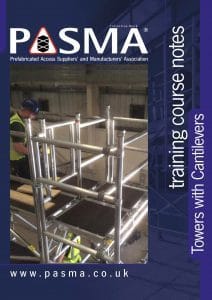New senior appointment at Actavo


 As part of its ongoing commitment to improving safety and standards in the international mobile access tower industry, the Prefabricated Access Suppliers’ and Manufacturers’ Association (PASMA) has launched a new advanced training course: Towers with Cantilevers.
Developed after extensive consultation with PASMA members and the tower-using industries, and enjoying the unqualified support of manufacturers, who, together with PASMA’s technical and training committees contributed wide-ranging expertise, ‘Towers with Cantilevers’ is the latest in a series of advanced courses that reflects the fast growing use of towers in more complex and demanding applications.
It is aimed at a diverse range of industry sectors – including construction, refurbishment, cleaning and facilities management – where access is required over fragile surfaces and large or awkward structures.
Developed specifically for the more experienced tower user, ‘Towers with Cantilevers’ explains and illustrates the essential principles of counterbalance when using kentledge in cantilever calculations.
It also interprets and explains the relevant sections of BS 1139-6:2014, the standard that specifies the requirements for complex structures such as towers with cantilevers that are outside the scope of BS EN 1004, the European product standard for normal towers.
PASMA points out that ‘Towers with Cantilevers’ focuses entirely on how to assemble and dismantle these advanced tower structures – together with their limitations – in standard configurations supported by the relevant manufacturer’s instruction manual.
Available only from PASMA approved training centres, the course is open to anyone with experience of assembling, dismantling, altering, moving and inspecting mobile access towers and who has successfully completed the Association’s ‘Towers for Users’ course.
Comments director of training, Stuart Hopkins: “This training course, which combines both theory and practical, serves to further enhance the competency of tower users across the access industry.”
“It joins a growing portfolio of courses designed to keep people safe and productive – and which will shortly be joined by other PASMA advanced courses to complete the portfolio of training to support advanced tower use.”
As part of its ongoing commitment to improving safety and standards in the international mobile access tower industry, the Prefabricated Access Suppliers’ and Manufacturers’ Association (PASMA) has launched a new advanced training course: Towers with Cantilevers.
Developed after extensive consultation with PASMA members and the tower-using industries, and enjoying the unqualified support of manufacturers, who, together with PASMA’s technical and training committees contributed wide-ranging expertise, ‘Towers with Cantilevers’ is the latest in a series of advanced courses that reflects the fast growing use of towers in more complex and demanding applications.
It is aimed at a diverse range of industry sectors – including construction, refurbishment, cleaning and facilities management – where access is required over fragile surfaces and large or awkward structures.
Developed specifically for the more experienced tower user, ‘Towers with Cantilevers’ explains and illustrates the essential principles of counterbalance when using kentledge in cantilever calculations.
It also interprets and explains the relevant sections of BS 1139-6:2014, the standard that specifies the requirements for complex structures such as towers with cantilevers that are outside the scope of BS EN 1004, the European product standard for normal towers.
PASMA points out that ‘Towers with Cantilevers’ focuses entirely on how to assemble and dismantle these advanced tower structures – together with their limitations – in standard configurations supported by the relevant manufacturer’s instruction manual.
Available only from PASMA approved training centres, the course is open to anyone with experience of assembling, dismantling, altering, moving and inspecting mobile access towers and who has successfully completed the Association’s ‘Towers for Users’ course.
Comments director of training, Stuart Hopkins: “This training course, which combines both theory and practical, serves to further enhance the competency of tower users across the access industry.”
“It joins a growing portfolio of courses designed to keep people safe and productive – and which will shortly be joined by other PASMA advanced courses to complete the portfolio of training to support advanced tower use.” 
Commenting on the contract award Joe Oatley, Chief Executive of Cape, said “I am delighted that Cape has been able to secure this important contract and we look forward to developing our relationship with ConocoPhillips further”.
 The Company was formed in 1991 in Nottingham, to provide an independent scaffold inspection as a joint venture between the UK Scaffolding Company SGB and Hinton & Higgs Ltd, Europe’s largest Construction Health and Safety Consultancy.
The Company was formed in 1991 in Nottingham, to provide an independent scaffold inspection as a joint venture between the UK Scaffolding Company SGB and Hinton & Higgs Ltd, Europe’s largest Construction Health and Safety Consultancy.